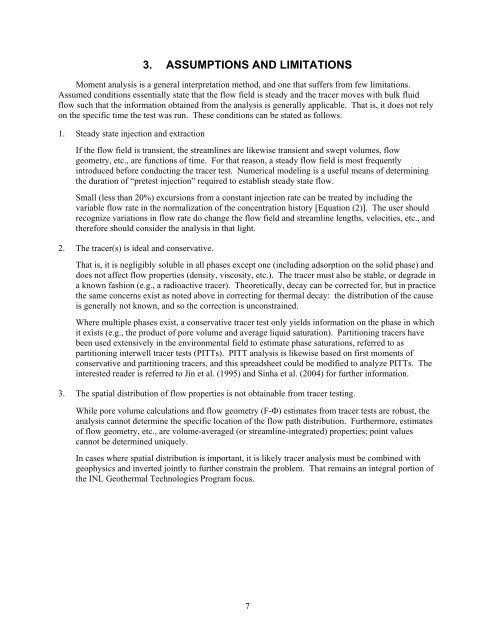Tracer Interpretation Using Temporal Moments on a Spreadsheet G
Tracer Interpretation Using Temporal Moments on a Spreadsheet G
Tracer Interpretation Using Temporal Moments on a Spreadsheet G
Create successful ePaper yourself
Turn your PDF publications into a flip-book with our unique Google optimized e-Paper software.
3. ASSUMPTIONS AND LIMITATIONS<br />
Moment analysis is a general interpretati<strong>on</strong> method, and <strong>on</strong>e that suffers from few limitati<strong>on</strong>s.<br />
Assumed c<strong>on</strong>diti<strong>on</strong>s essentially state that the flow field is steady and the tracer moves with bulk fluid<br />
flow such that the informati<strong>on</strong> obtained from the analysis is generally applicable. That is, it does not rely<br />
<strong>on</strong> the specific time the test was run. These c<strong>on</strong>diti<strong>on</strong>s can be stated as follows.<br />
1. Steady state injecti<strong>on</strong> and extracti<strong>on</strong><br />
If the flow field is transient, the streamlines are likewise transient and swept volumes, flow<br />
geometry, etc., are functi<strong>on</strong>s of time. For that reas<strong>on</strong>, a steady flow field is most frequently<br />
introduced before c<strong>on</strong>ducting the tracer test. Numerical modeling is a useful means of determining<br />
the durati<strong>on</strong> of “pretest injecti<strong>on</strong>” required to establish steady state flow.<br />
Small (less than 20%) excursi<strong>on</strong>s from a c<strong>on</strong>stant injecti<strong>on</strong> rate can be treated by including the<br />
variable flow rate in the normalizati<strong>on</strong> of the c<strong>on</strong>centrati<strong>on</strong> history [Equati<strong>on</strong> (2)]. The user should<br />
recognize variati<strong>on</strong>s in flow rate do change the flow field and streamline lengths, velocities, etc., and<br />
therefore should c<strong>on</strong>sider the analysis in that light.<br />
2. The tracer(s) is ideal and c<strong>on</strong>servative.<br />
That is, it is negligibly soluble in all phases except <strong>on</strong>e (including adsorpti<strong>on</strong> <strong>on</strong> the solid phase) and<br />
does not affect flow properties (density, viscosity, etc.). The tracer must also be stable, or degrade in<br />
a known fashi<strong>on</strong> (e.g., a radioactive tracer). Theoretically, decay can be corrected for, but in practice<br />
the same c<strong>on</strong>cerns exist as noted above in correcting for thermal decay: the distributi<strong>on</strong> of the cause<br />
is generally not known, and so the correcti<strong>on</strong> is unc<strong>on</strong>strained.<br />
Where multiple phases exist, a c<strong>on</strong>servative tracer test <strong>on</strong>ly yields informati<strong>on</strong> <strong>on</strong> the phase in which<br />
it exists (e.g., the product of pore volume and average liquid saturati<strong>on</strong>). Partiti<strong>on</strong>ing tracers have<br />
been used extensively in the envir<strong>on</strong>mental field to estimate phase saturati<strong>on</strong>s, referred to as<br />
partiti<strong>on</strong>ing interwell tracer tests (PITTs). PITT analysis is likewise based <strong>on</strong> first moments of<br />
c<strong>on</strong>servative and partiti<strong>on</strong>ing tracers, and this spreadsheet could be modified to analyze PITTs. The<br />
interested reader is referred to Jin et al. (1995) and Sinha et al. (2004) for further informati<strong>on</strong>.<br />
3. The spatial distributi<strong>on</strong> of flow properties is not obtainable from tracer testing.<br />
While pore volume calculati<strong>on</strong>s and flow geometry (F-) estimates from tracer tests are robust, the<br />
analysis cannot determine the specific locati<strong>on</strong> of the flow path distributi<strong>on</strong>. Furthermore, estimates<br />
of flow geometry, etc., are volume-averaged (or streamline-integrated) properties; point values<br />
cannot be determined uniquely.<br />
In cases where spatial distributi<strong>on</strong> is important, it is likely tracer analysis must be combined with<br />
geophysics and inverted jointly to further c<strong>on</strong>strain the problem. That remains an integral porti<strong>on</strong> of<br />
the INL Geothermal Technologies Program focus.<br />
7
















